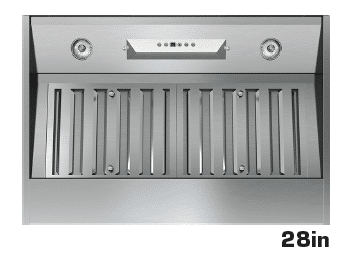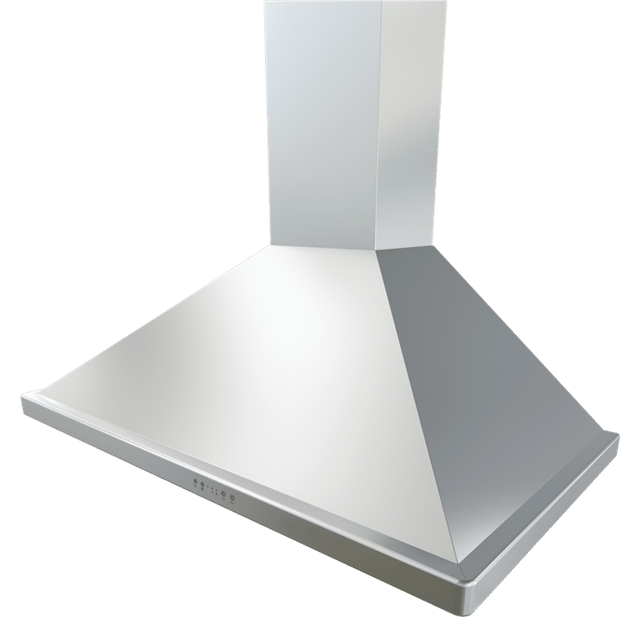Four hundred CFM has become the ceiling cap for all hoods before you have to consider adding a make-up air system in your home.
If this sounds foreign to you, in this article, we will explain basic venting as well as makeup air and then look at the best hoods for makeup air.
[inlineCTA]
First, what is CFM?
CFM is cubic feet per minute. This describes how much air volume is being moved in or out of a space. For venting, a 400 CFM rating means 400 cubes of air are being exhausted out of your home every minute.
Make-up Air
In 2009, Massachusetts adopted a stretch code for any range hood capable of extracting over 400 cubic feet per minute. You must also install a make-up air system to replace the air drawn outside.
Below is the code:
Code 1503.4: "Exhaust hood systems capable of exhausting in excess of 400 cubic feet per minute (0.19 m3/s) shall be provided with makeup air at a rate approximately equal to the exhaust air rate. Such makeup air systems shall be equipped with a means of closure and shall be automatically controlled to start and operate simultaneously with the exhaust system."
Today, this code is enforced for the majority of new construction and renovation projects in Massachusetts.
Homes are built to much tighter tolerances so you now have to make exhausted air with fresh outside air. In years past, homes allowed air in, so it was not a concern. The installation of a makeup air system can sometimes be confusing, costly or impossible depending on your residence, especially if you are simply remodeling.
Should I buy a hood under 400 CFM to avoid make-up air?
It depends. If you are not going to install a makeup air system, your selection of cooking products should be limited to electric, induction, or non-professional gas appliances.
If possible, don't skimp on good ventilation. Kitchen cabinets accumulate about 4 gallons of grease per year without ventilation. It’s really gross if you think about it…
If you cook frequently you should invest in good ventilation. If you are buying a professional-style range you will likely be investing in a make-up air system as well.
You might want to avoid make-up air if: you are in a condo association that doesn’t let you install a separate return, or if you want to avoid the cost and hassle of installing the system. Local codes are stricter than ever on make-up air systems causing many people to buy low CFM range hoods.
How do I optimize my ventilation performance?
Choosing good ventilation comes down to three factors:
1. Hood Power (measured in CFM)
Your vent power (CFM) is determined by what kind of cooking surface you choose. Pro-style gas will need a high CFM vent hood, electric and induction cooking have less residual heat and therefore don’t require as-powerful CFM.
2. How a Hood is Ducted
How your hood is ducted is important. The best way to duct your hood is straight up. You eliminate the effectiveness of your hood with each elbow or a number of times you alter the duct.
3. Capture Area
To put this simply, capture area is the amount of area on the hood above the cooking surface designated to capture smoke and grease. Visually, this is the baffles or mesh filters that you physically see. The bigger the capture, the better the performance.
Capture area is key. You can take a 400 CFM vent hood and a 400 CFM over-the-range microwave and run them side-by-side. The hood will always exhaust better.
Hoods have more capture area than microwaves. Over professional style ranges, many people choose to oversize their hood for better capture area.
Best Hoods Under 400 CFM
Today, Yale's private hood series comes with ACT technology offering you a make-up air compatible hood selection at 390 CFM.
The Problem
In the past, if you were planning to avoid installing make-up air you were limited to low CFM, low design type of hoods. There is a very limited selection and the options out there were generally lower quality models.
What is ACT Technology?
Certain hoods have ACT Technology which allows you to limit the airflow of the hood to meet local code requirements. Hoods with ACT can have their power reduced to 590, 390, or 290 CFM to meet makeup air standards.
Fortunately, with the addition of Active Airflow Technology or (ACT technology) expanded the selection of make-up air convertible attractive hoods.
Best Make-Up Air Hoods
At Yale, we have our own line of private label hoods. This collection of hoods is attractive, and are make-up air compatible with ACT technology.

Features:
- 600 CFM Internal Blower
- 3-speed, electronic LED controls
- Sturdy stainless-steel construction
- 2 aluminum mesh filters
- Optional recirculation kit
- Standard telescopic duct covers up to 9’ ceilings
- Optional duct cover extensions for up to 12’ ceilings
- Designed for 6-inch vertical ducted installations

Features:
- Custom wood hood insert
- stainless steel baffles
- controls 6-speed, electronic touch
- lights (2) dual-level halogen
- filters (2) professional baffle
- Top or rear venting

Features:
- ACT Techonolgy
- 600 CFM Internal Blower
- 3-Speed, Electronic LED Controls
- 3 Speed Levels
- Stainless Steel
- 2-50W Dual-Level Halogen Lights – can accept LED bulbs
- Recirculating optional with accessories
- 2 Aluminum Mesh Filters
- 6" Round Duct

Features:
- ACT Technology
- 600 CFM Internal Blower
- 3-speed, electronic LED controls
- Sturdy stainless-steel construction
- 2 aluminum mesh filters
- Optional recirculation kit
- Standard telescopic duct covers up to 9’ ceilings
- Optional duct cover extensions for up to 12’ ceilings
- Designed for 6-inch vertical ducted installations
Final Thoughts
I want to reiterate, if you are not going to install a make-up air system, your selection of cooking products could be limited to electric, induction, or non-professional gas appliances.
If you are buying a professional range, you must also buy a make-up air system. The key to good venting is planning.
If you want to avoid makeup air, I would suggest looking into hoods with ACT technology because it increases your selection.
You should also consider reading our ventilation buyers guide to understanding how to plan your venting including capture, the best filters and the best way to duct.
Additional Resources
Venting is very important, especially if you like to cook. You do not want lingering odors and grease in your home. So if you have questions about hoods and how to vent, download our Yale Ventilation Buying Guide with advice on how to vent properly, advantages of an exterior, interior, and inline ducting as well as recommended CFMs for all the different ranges.

Why Should You Trust Us?
It seems that every appliance review has nothing but glowing comments about almost every product, yet you read customer reviews and they are almost universally bad.
We are here to fill in the disconnect. We'll give you the best features, and the drawbacks as well, including reliability based on over 37,000 calls performed by our service team just last year. Our goal is to give you ALL the information so you know what's right for you.
Please consider subscribing or adding to the conversation in the comments below. We appreciate you stopping by.
Steve Sheinkopf
Steve Sheinkopf is the third-generation CEO of Yale Appliance and a lifelong Bostonian. He has over 38 years of experience in the appliance industry, and he is a trusted source of information for consumers on how to buy and repair appliances.
Steve has also been featured in numerous publications, including the
New York Times,
Consumer Reports,
The Boston Globe,
Bloomberg Radio, the
New York Post,
The Wall Street Journal, and
Entrepreneur, for his knowledge of how to buy appliances and appliance repair.
Steve is passionate about helping consumers find the best appliances for their needs, and he is always happy to answer questions and provide advice. He is a valuable resource for consumers who are looking for information on appliance buying, repair, and maintenance.
Despite being the worst goalie in history, Steve is a fan of the Bruins and college hockey, loves to read, and is a Peloton biker. The love of his life is his daughter, Sophie.






